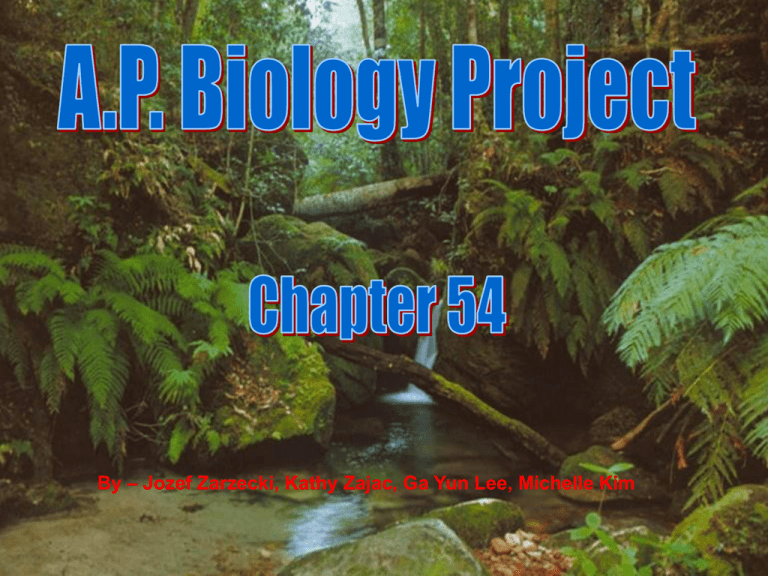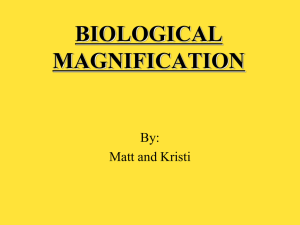– Jozef Zarzecki, Kathy Zajac, Ga Yun Lee, Michelle Kim By
advertisement

By – Jozef Zarzecki, Kathy Zajac, Ga Yun Lee, Michelle Kim 54.1-Ecosystem ecology emphasizes energy flow and chemical cycling. •Plants and other photosynthetic organisms convert solar energy to chemical energy, but the total amount of energy never changes. •The trophic level that ultimately supports all others consists of autotrophs, also called the primary producers of the ecosystem. •Heterotrophs directly or indirectly depend on the photosynthetic output of primary producers. •Herbivores which eat primary producers such as plants are primary consumers. •Carnivores eating herbivores are secondary consumers, and carnivores eating other carnivores are tertiary consumers. •Detrivores are consumers that get their energy from detrus, which is nonliving organic matter. 54.2-Physical and chemical factors limit primary production in ecosystems •The total primary production in an ecosystem is known as the gross primary production (GPP) which is the amount of light energy converted to chemical energy through photosynthesis per unit time. •Net primary production (NPP) is the amount of new biomass added in a given period of time which equals the GPP minus the energy used by the primary producers for respiration. •Primary production is limited by light. Most solar radiation is absorbed, scattered, or reflected by the atmosphere. Only some wavelengths are suitable for photosynthesis, and if light has to reach underwater plants, most of it is absorbed by the water. •Primary production is limited by nutrients. A limiting nutrient is the element that must be added in order for production to increase in a particular area. •Temperature and moisture also control primary production. With wet and warm condition comes a lot of primary production. Actual evapotranspiration is the annual amount of water transpired by plants and evaporated. It also rises with wet and warm conditions and has a positive relationship with NPP. 54.3-Energy transfer between trophic levels is usually less that 20% efficient •The amount of chemical energy in consumers food that is converted to their own new biomass during a given time period is called the secondary production. •Production efficiency is the faction of energy stored in food that is not used for respiration. •Trophic efficiency is the percentage of production transferred from one trophic level to the next. •Pyramid of net production- trophic levels are stacked in blocks with primary producers forming the foundation of the pyramid. •Biomass pyramid- each tier represents the standing crop in one trophic level. •Pyramid of numbers- size of each block is proportional to the number of individual organisms present in that trophic level. •Green world hypothesis- terrestion herbivoes consume relatively little plant biomass because they are held in check by a variety of factors. Such as predators, parasites, disease, plant defenses, and abiotic factors. 54.4-Biological and geochemical processes move nutrients between organic and inorganic parts of the ecosystem •Life on earth depends on the recycling of essential chemical elements by decomposers who take complex molecules of organisms and return it to the atmosphere, water, or soil as simpler compounds. •The nitrogen cycle often limits plant nutrition. Nitrogen enters an ecosystem via nitrogen fixation, which is the conversion of N2 by bacteria to forms that can be used to synthesize nitrogenous organic compounds. •Four important factors that ecologists consider as they research biochemical cycles are: The biological importance of each chemical, the forms in which each chemical is available or used by organisms, The major reservoirs for each chemical and the key processes that drive the movement of each chemical through its biochemical cycle. •Temperature and the availability of water affects rates of decomposition and thus nutrient cycling times. •Plants absorb and transpire water from the soil and without plants water runoff will increase about 30-40% 54.5-The human population is disturbing chemical cycles throughout the biosphere. •Human activity often intrudes in nutrient cycles by removing nutrients from one part of the biosphere and adding them into another. •Nitrogen is the main nutrient lost through agriculture, plowing and deliberat burning of fields releases nitrogen from the soil. •Critical load is the amount of added nutrient that can be absorbed by plants without damaging ecosystem integrity. •Burning of fossil fuels releases oxides of sulfur and nitrogen that react with water to form sulfuric and nitric acid. This then falls down as acid rain and can harm plants, and animals in the environment. •Toxins become more concentrated in successive trophic levels of a food web, a process called biological magnification. This occurs because the biomass at any level is composed of a greater biomass ingested from a lower level. •CO2 in the atmosphere retains solar heat in a process called the greenhouse effect. The protective ozone layer is being depleted because of chlorofluorocarbons which are used by humans. Elixir of Death: An Overview of the Effects of DDT •"In less than two decades of their use," Rachel Carson writes, "synthetic pesticides have been so thoroughly distributed throughout the world that they occur virtually everywhere." •These chemicals have been recovered from most major river systems as well as from streams of groundwater flowing beneath the earth's surface. •Chemicals linger in the soil a dozen years after application and lodge themselves in the bodies of fish, birds, reptiles, and domestic and wild animals. •These chemicals that are meant to eliminate the mosquitoes and other "pests" that are supposedly harming our agriculture end up killing many of the species that are beneficial, affecting entire food webs and creating a chain reaction of pandemonium. DDT and the Water Cycle. •Although not always directly applied to bodies of water a large amount of chemical pollution finds its way to our water systems. •Some bodies of water are sprayed directly to destroy undesirable plants, insect larvae, or fish. Some chemicals drip down from leafy canopies to the forest floor and become part of the slow movement of seeping moisture journeying to the sea. Some chemicals applied to farmland are leached out of the ground by rain. •It is only time before DDT and other chemicals become evaporated along with the water and become part of the cycle, raining down on the land and seeping down into the cracks in soil and rock until they finally enter the groundwater. •From there, the poison spreads everywhere (to places many miles away from where the chemical was sprayed originally) and it is not long before the fishes and the water birds begin to die. DDT in Our Soil •As DDT seeps through the soil into the groundwater systems it goes without saying that the soil itself becomes affected as well. •DDT is sprayed over canopies of trees or over farmland or is carried by the rain to a certain area where it falls over the soil. •While it kills the harmful insects that are damaging to crops it also ends up killing the "good" insects whose job it is to decompose organic matter. •With these decomposers eliminated the trees and plants are unable to absorb the needed nutrients which could have dramatic effects on the population of vegetation. DDT's Effects on Earth's Trophic Levels •DDT is not a vicious chemical because it kills. It is vicious because when it kills, it does not only affect those populations it kills but the many other species who depend on the eliminated population. •When elms are sprayed, the robins nesting in the trees die because of the way the poison traveled from elm leaf to earthworm, and finally to the robin. •Or when, after years of spraying, the willows in the Bridger National Forest in Wyoming finally shriveled and died. The moose that had inhabited the forest were gone, as were the beavers now that the willow they had fed on was gone. With the beavers gone their dams broke down and a large nearby lake drained out leaving only a tiny creek where no large trout remained. •They could not bare to live in a bare, hot land where no shade from the willows remained. Acid Precipitation- Affects the water cycle and the soil •The burning of wood and of coal and other fossil fuels releases oxides of sulfur and nitrogen into the atmosphere. These oxides react with water in the air and form sulfuric and nitric acid. •Eventually when the moisture builds up this acid falls to Earth’s surface as acid precipitation (i.e. rain, snow, sleet, fog), damaging crops and contaminating the soil. •Acid precipitation is harmful to aquatic ecosystems as well as terrestrial ecosystems because it lowers the pH level of aquatic ecosystems and drains the nutrients from the soil. •With lowered pH levels and nutrient deficiencies both the health of sea creatures and plants are affected. Mad Cow Disease and the Web of Life •Mad Cow Disease is a serious current problem that is not only harmful to the cow that has the disease but to all those with whom it is linked in the food chain. •The disease originates within the grass the cows eat. It causes a deformation in the protein of prion stored within the cow’s body and thus becomes what is know as mad cow disease. •Many cows die from this disease, causing a large population decrease that throws off the entire food chain. •Also, while attempts are made to prevent infected meet reaching the market some meet could leak through and come into human hands. •If a human were to eat the infected meat they would die as well, thus harming the entire food chain…





